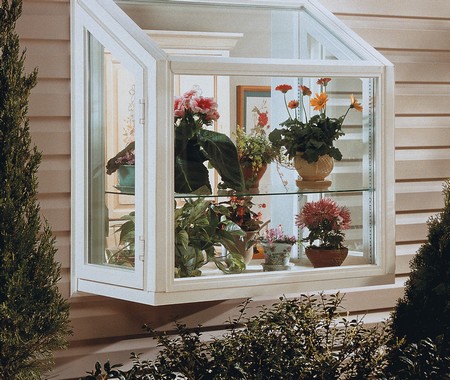The first step towards creating handsome window garden displays is, naturally, to choose your containers; and there is a vast range available, from highly ornate troughs to the simplest of wooden boxes.
Like many gardeners, I prefer my plants to be the main attraction, rather than their containers; so for preference I would usually go for something fairly simple and plain which won’t fight with the flowers for attention. It’s all a matter of personal taste, but do remember that a highly decorated or brightly coloured box may appeal when seen in the store but look very unnatural and clash with the flowers when planted up.

It’s also best if the window boxes don’t clash too much with the style of the building, either. The one situation where you could perhaps get away with having very intricately designed and ornamented containers would be where the architecture is equally ornate; for example, in a Spanish style, against which more intricate boxes wouldn’t seem so out of place.
However, something plain and more utilitarian, with clean lines and a neutral colour, would better suit the vast majority of buildings (particularly modern ones) as well as setting the plants off to better effect.
Colour
Speaking of colour, you can of course select or paint containers to match the paintwork of your windows, and this can look very effective, but bear in mind that white boxes will need annual repainting and regular cleaning (particularly in urban areas), otherwise they’ll quickly become dirty and unsightly.
Boxes may also be chosen or painted in a colour to blend with the walls (e.g. brick-red, stone hues, or to match coloured rendering or painted walls) and this is especially effective where the containers are to be fixed on brackets just below the windows, rather than actually on the sills.
If in doubt, play safe and opt for subdued lake window tinting like dark green, beige, brown or plain varnished timber, all of which will offset plants and flowers well. Bear in mind also, if you’re hand-painting, that a matt finish generally looks more subdued and blends in better than a high-gloss paint (unless you’re matching it to existing glossy paintwork.)
Material
Plastic troughs are light to handle and should have a long life provided they’re made from good heavy-duty material; very thin and flimsy poor quality plastics may quickly become brittle in sunlight, making them prone to cracking and breakage.
Be wary when buying decorative metal containers as well. Wrought iron and steel may be robust but can quickly start to rust unless well coated with paint or plastic against the elements, and no-one wants unsightly rain-washed rust stains disfiguring the house; particularly where the walls are white or of a very pale colouring.
Glass fibre is a good choice, tough and very long-lasting, and unglazed eathenware pottery troughs look very classy. I really don’t think you can beat good old-fashioned timber; it’s comparatively inexpensive (especially if you build your own boxes); it lasts well if treated inside with preservative; it’s easily painted to suit your requirements and looks particularly good when clear varnished to make a handsome feature of the wood grain. It you can obtain rough-cut planks complete with bark edgings, or a bark-covered facing timber, these will give your window gardens a particularly attractive rustic look: lovely on an older house, and an interesting natural contrast to an ultra-modern frontage or a large picture window.
Size
The box should be as large as the window ledge will allow. The more planting compost it holds, the longer it’ll take to dry out between waterings, which means less work and worry; and of course you’ll be able to squeeze in more plants in greater variety for a really marvellous display.

Shallow containers should be avoided wherever possible, as these dry out fastest of all and therefore demand very trequent watering. Anything shallower than 15 cm (6 in) is likely to cause trouble, and 20 cm (8 in) or more is better.
You needn’t settle for a very narrow box even if the window sill is shallow; your container can project out a little way from the sill without looking odd, and on an extremely narrow ledge a wide box can be supported at the front with wall brackets.